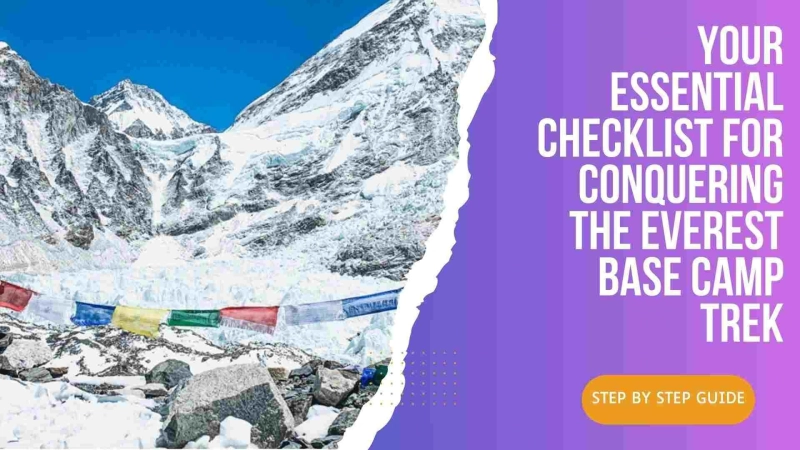Embarking on the Everest Base Camp Trek is a dream come true for adventure enthusiasts and nature lovers alike. Nestled in the heart of the Himalayas, this iconic trek offers breathtaking views, a glimpse into the Sherpa culture, and the ultimate sense of achievement. But before you lace up your boots and hit the trail, it's important to be well-prepared. In this comprehensive guide, I will take you step-by-step through the essential checklist for conquering the Everest Base Camp Trek.
Overview of the Everest Base Camp Trek
The Everest Base Camp Trek, also known as the EBC Trek, is a challenging yet rewarding journey that takes you to the foot of the world's highest peak - Mount Everest. Starting from Lukla, a small town in Nepal, the trek winds through picturesque Sherpa villages, suspension bridges, and lush valleys, offering breathtaking views of snow-capped mountains along the way. The highlight of the trek is reaching Everest Base Camp, where climbers prepare for their ascent to the summit.
How difficult is the trek to Everest Base Camp?
The Everest Base Camp Trek is considered a moderate to challenging trek. The altitude, rugged terrain, and unpredictable weather conditions make it physically demanding. However, with proper preparation and training, anyone with an average level of fitness can conquer this trek. It is crucial to acclimatize to the high altitude gradually and listen to your body's needs. Taking rest days, staying hydrated, and maintaining a slow and steady pace will help minimize the risks associated with altitude sickness.
How to prepare for the Everest Base Camp Trek
Preparing for the Everest Base Camp Trek is essential to ensure a safe and enjoyable experience. Here's a checklist to help you get ready:
Physical Fitness: Start a regular exercise routine at least three months before the trek. Focus on cardiovascular exercises, such as hiking, running, or cycling, to improve your endurance. Incorporate strength training to build muscle strength and stamina.Mental Preparation: The Everest Base Camp Trek can be mentally challenging. Prepare yourself mentally by visualizing the journey, setting realistic goals, and maintaining a positive mindset. Research about the trek, watch documentaries, and connect with experienced trekkers to get a better understanding of what to expect.Obtain the necessary permits: Before starting the trek, you will need to obtain two permits - the Sagarmatha National Park Permit and the TIMS (Trekkers' Information Management System) card. These permits can be obtained from the Nepal Tourism Board in Kathmandu or through registered trekking agencies.Essential gear and equipment for the Everest Base Camp Trek
Having the right gear and equipment is crucial for a successful Everest Base Camp Trek. Here are the essentials:
Trekking Boots: Invest in a good pair of waterproof and sturdy trekking boots that provide ankle support. Make sure to break them in before the trek to avoid blisters.Clothing: Layering is key to staying warm in the ever-changing weather conditions. Pack moisture-wicking base layers, insulating mid-layers, and a waterproof and windproof outer shell. Don't forget a warm hat, gloves, and a buff or scarf to protect your face from the cold.Backpack: Choose a backpack with a capacity of around 50-60 liters to carry your essentials. It should have a comfortable hip belt and shoulder straps for even weight distribution.Training and fitness for the Everest Base Camp Trek
Training and fitness are crucial for a successful Everest Base Camp Trek. Here are some tips to prepare your body for the demands of the trek:
Cardiovascular Exercises: Engage in activities like hiking, running, cycling, or swimming to improve your cardiovascular endurance. Aim for at least 30 minutes of moderate-intensity exercise, five days a week.Strength Training: Strengthen your leg muscles, core, and upper body to handle the uphill and downhill sections of the trek. Include exercises like squats, lunges, planks, push-ups, and shoulder presses in your workout routine.Altitude Training: Since the trek involves high altitudes, it's beneficial to simulate altitude conditions before your trip. Consider training at higher elevations or using an altitude training mask to adapt your body to lower oxygen levels.What to expect on the Everest Base Camp Trek
The Everest Base Camp Trek is a journey filled with awe-inspiring landscapes, challenging trails, and cultural encounters. Here's what you can expect along the way:
Scenic Beauty: From the lush green forests of Sagarmatha National Park to the towering peaks of the Himalayas, the trek offers breathtaking vistas at every turn. Be prepared to witness stunning panoramas of Mount Everest, Lhotse, Nuptse, and other majestic mountains.Sherpa Culture: The trek takes you through several Sherpa villages, where you can immerse yourself in the rich Sherpa culture. Interact with the friendly locals, visit monasteries, and learn about their traditional way of life.Tea Houses: Along the trail, you will find cozy tea houses that provide accommodation and meals. These simple yet comfortable lodges offer a warm place to rest, enjoy delicious Nepali cuisine, and connect with fellow trekkers.How long is the trek from Lukla to Everest Base Camp?
The trek to Everest Base Camp covers a distance of approximately 65 km. The duration of the trek depends on your pace, acclimatization days, and overall fitness level. On average, it takes about 12-14 days to reach Everest Base Camp from Lukla, including rest days for acclimatization.
Accommodation and facilities on the Everest Base Camp Trek
During the Everest Base Camp Trek, you will stay in tea houses or lodges along the trail. These establishments provide basic accommodation with shared rooms and communal dining areas. Though the facilities are simple, you can expect a comfortable bed, warm blankets, and hearty meals. Keep in mind that the higher you ascend, the more basic the facilities become.
What is the cost of trekking to Everest Base Camp?
The cost of trekking to Everest Base Camp can vary depending on various factors, such as the duration of the trek, the level of comfort you prefer, and whether you choose to go independently or with a trekking agency. On average, the cost can range from $676 to $3,000 per person. This may include permits, accommodation, meals, a guide and porter, and transportation to and from Lukla.
Safety tips for the Everest Base Camp Trek
Safety should be your top priority during the Everest Base Camp Trek. Here are some essential safety tips to keep in mind:
Acclimatize Properly: Take rest days for acclimatization to allow your body to adjust to the high altitude. Ascend gradually and listen to your body's signals. If you experience symptoms of altitude sickness, descend immediately.Stay Hydrated: Drink plenty of fluids to stay hydrated at high altitudes. Avoid alcohol and caffeinated beverages, as they can contribute to dehydration.Follow the Trekking Etiquette: Respect the local culture, wildlife, and environment. Stick to designated trekking trails, refrain from littering, and be considerate towards fellow trekkers.Best time to trek to Everest Base Camp
The best time to trek to Everest Base Camp is during the pre-monsoon (spring) and post-monsoon (autumn) seasons. The months of March to May and September to November offer stable weather conditions, clear skies, and moderate temperatures. However, these are also the busiest seasons, so expect more trekkers on the trail and book your accommodations in advance.
Highlights and attractions along the Everest Base Camp Trek
The Everest Base Camp Trek is not just about reaching the base camp; it's a journey filled with incredible highlights and attractions. Here are a few notable ones:
Namche Bazaar: Known as the gateway to the Everest region, Namche Bazaar is a vibrant Sherpa town bustling with shops, markets, and bakeries. Take a day to explore this lively hub and enjoy stunning views of Kongde Ri and Thamserku.Tengboche Monastery: Situated at an altitude of 3,867 meters (12,687 feet), Tengboche Monastery is one of the most important Buddhist monasteries in the region. Attend the morning prayers and soak in the peaceful ambiance amidst the backdrop of Ama Dablam.Kala Patthar: Standing at an elevation of 5,545 meters (18,192 feet), Kala Patthar offers the best panoramic view of Mount Everest. Wake up early to catch the sunrise and witness the golden glow on the world's highest peak.Conclusion: Fulfilling your Everest Base Camp Trek dream
Embarking on the Everest Base Camp Trek is a once-in-a-lifetime adventure that requires careful planning and preparation. By following this step-by-step checklist, you can ensure a safe and fulfilling experience on the trail. From the breathtaking landscapes to the rich Sherpa culture, the Everest Base Camp Trek offers a truly unforgettable journey. So, lace up your boots, pack your bags, and get ready to conquer the mighty Himalayas. Your Everest Base Camp dream awaits!
Ready to embark on your Everest Base Camp adventure? Start preparing today and make your dream a reality! Remember to consult with a professional guide or trekking agency for personalized advice and assistance.


